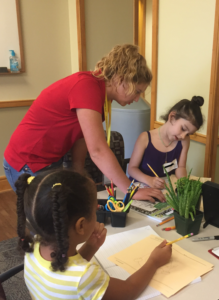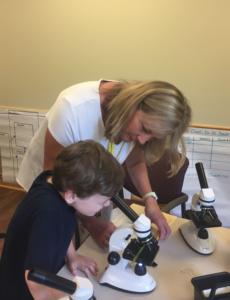Summer SAVY 2018: Session 5, Day 1 – Becoming a Botanist (Rising 1st)
We had a wonderful first day. Getting to know each other is always first and foremost, so we enjoyed a getting to know you activity. I love having previous students in new SAVY courses, as well as meeting new students! We have already established a close community of curious learners! We began with a pre-assessment concept map on plants to understand the pre-existing depth of knowledge our students have regarding the concept of plants. This type of early assessment helps guide our instruction to meet the needs of our students by differentiating their learning experiences. As a post assessment, students will do the same concept map, plants, on Friday, the last day of our SAVY course, to show how their knowledge of plants has expanded and become more in depth.
“What is a plant?” I posed to our young botanists. Well, to truly answer this question, we had to use our scientific senses of observation to figure this out, hands on. This meant, going outside with our Science Journals! Off we went to seek characteristics, confirm what we believed to be true but needed to classify and generalize, and open our minds to new possibilities through different lenses of observation on how plants are connected to their environment and somehow connected within their own structures (we will build on this knowledge through our week). But, all scientists know that collecting specimens to evaluate back at the lab is essential to making scientific investigations, so we brought back a plethora of items to study under our microscopes. Backyard investigations are the best! From this fruitful (pun intended), investigation, the class began a plant concept map, as well as questions that need to be answered through scientific investigation.
Our next investigation took us to beans. We wanted to learn what was inside a bean and the process of this plant’s life cycle. To do this, we opened up our science notebooks and used our senses, like a scientist, to evaluate, draw and record what a dry bean looked like. Students noted physical characteristics such as hard, smooth, looked like a white skin is on it, and it could be broken into pieces and if carefully done, in half. We taped the dry bean into our notebook and then the wonder took over as I opened up another container with lima beans in it, but this time, students noted that they were in water! Each of us took one soaked bean and compared the physical characteristics of the this bean to the previously observed dry bean, Students notes all kinds of differences, and then, we gently and intentionally peeled back the “skin”, and students learned that this is a seed coat! The rest of the investigation was somewhat of a marvel as more information of the beans life cycle came into view, as we discovered the tiny root tucked inside and the inside food storage. Perhaps the most exciting wrap up to this investigation was each student learned they would make their own tiny greenhouse in a zip lock bag to grow their own lima bean! Tomorrow, students will check on the growth of their greenhouse lima beans.
Plantation discussion (pun intended): If you have time tonight, please encourage your young botanist to select a plant at home to study. Using budding botanist understanding of plants, ask your student to analyze this plant for parts (elements) that work together to accomplish a goal. I am hoping each student will observe their plant daily, and bring their home study plant to the Open House to tell others how their plant is a “system” as we learn more about the plant system in class.
More tomorrow. It has bean a great day. Can’t wait until tomorrow!
Ms. Tyson
Some of Today’s Highlights


